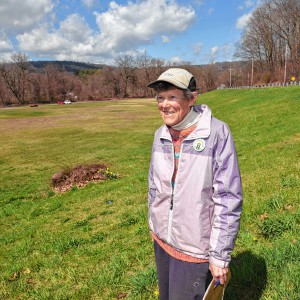Learning to make mascarpone and pasta: Recipes from the Hawlemont Agriculture and You program
| Published: 05-30-2023 3:47 PM |
Hawlemont School in Charlemont is justly renowned for its pioneering H.A.Y. program. H.A.Y. stands for Hawlemont Agriculture and You. Taking inspiration from its rural surroundings, the school teaches elementary-school students the basics of agriculture.
The youngsters grow crops, tend a greenhouse, care for animals, and learn traditional crafts such as cheese making and weaving.
On Saturday, May 20, I attended the school’s annual H.A.Y. Conference. Once a year the school opens its doors to offer workshops to the public – adults and children – on subjects such as crafts, gardening, tree care and cooking.
We attended three 75 minute sessions, and lunch was served after the first two sessions. The menu included quesadillas, paneer (an Indian cheese made by students in the first session), a bevy of soups, and assorted baked goods.
Workshops included chicken or rabbit husbandry; log cabin and sauna building techniques; microgreen growing; salve making; soap creation; and a number of food-related sessions, from making jams and jellies to the creation of different kinds of cheeses. There was even a session on darning socks.
I opted for food workshops, of course. In the first session, my group made mascarpone with nurse, goat enthusiast and Heath resident, Sheila Litchfield.
Sheila first taught us how to pronounce the name of this cheese and then led us through its relatively easy creation. Each participant ended the session with a batch of mascarpone for later use.
Sheila’s calm demeanor helped when our cream didn’t begin to coagulate at first; she suggested we heat the cream again briefly and add a little more tartaric acid, the powder that helps the cream curdle. In no time at all, all of us – including Sheila’s composed young granddaughter, Maeven – were in the cheese business.
Article continues after...
Yesterday's Most Read Articles
 Greenfield man arrested in New York on murder charge
Greenfield man arrested in New York on murder charge
 Man allegedly steals $100K worth of items from Northampton, South Deerfield businesses
Man allegedly steals $100K worth of items from Northampton, South Deerfield businesses
 Greenfield Police Logs: April 9 to April 17, 2024
Greenfield Police Logs: April 9 to April 17, 2024
 Former Leyden police chief Daniel Galvis charged with larceny
Former Leyden police chief Daniel Galvis charged with larceny
 Shea Theater mural artist chosen out of 354 applicants
Shea Theater mural artist chosen out of 354 applicants
 Millers Meadow idea would ‘completely transform’ Colrain Street lot in Greenfield
Millers Meadow idea would ‘completely transform’ Colrain Street lot in Greenfield
One of the workshop participants, Liz, happily gathered up the whey (the liquid leftover when the cheese drains) at the end of the workshop to feed to her chickens.
In my second workshop, many of the same participants were walked through the creation of homemade pasta by Chelsea Jordan-Makely, a library consultant and the director of the Griswold Memorial Library in Colrain.
Chelsea and Sheila differed, as cooks and as instructors, as befitted their subject matter. Sheila was intensely organized. Cheesemaking requires precision. In contrast, Chelsea’s message was, “Pasta making is really chill.” She gently but enthusiastically showed us how to stir together the two necessary ingredients, 2 cups flour and 2 eggs. She advised cooking by instinct.
Chelsea showed us how to use a pasta roller for best results. The end product from her class was tender and delicious.
After lunch, I returned to Sheila, where the group from her earlier session made tiramisu using the mascarpone we had created earlier in the day.
The recipe involved grating chocolate and nuts, dipping ladyfingers in coffee, whipping egg yolks and whites separately, and then layering everything together with the mascarpone.
There were a few slightly stressful moments. The chocolate proved difficult to grate, especially for people like me who were impatient. And we were short on counter space so I actually flubbed the process of separating one of my eggs. (It was quickly replaced by one fresh from a Hawlemont H.A.Y. program hen!)
Despite the complex recipe, Sheila helped each of us end the session with a pan of tiramisu to take home.
I could tell at a glance who were the most efficient graters of chocolate and nuts. My version of tiramisu had a lot of large clumps on top, while others had a tiny dusting of nuts and chocolate. Despite these differences in appearance, I’m sure everyone’s tiramisu was delicious. Mine certainly was.
Fortunately, I could share it with neighbors. The recipe produced way too much rich pudding for a single person to consume.
Next year, I hope to try more classes… and even to teach one if the school invites me to do so. Meanwhile, the day left me with a warm feeling toward Hawlemont School and the people who run it. I also came home with some new skills… and a yen to purchase a pasta roller.
Here is Sheila’s recipe for mascarpone. The tartaric acid and a dairy thermometer may be ordered from New England Cheesemaking Supply in Northampton (cheesemaking.com).
You may use this rich, soft cheese to make your own tiramisu, or as a topping for fruit or cakes. Some people use it in cheesecake because it is similar to cream cheese. Sheila also notes that it’s great with figs or even in a mascarpone fudge.
Happy curdling!
Ingredients:
1 quart light cream
1/8 to 1/4 teaspoon tartaric acid
Equipment:
a 1-1/2-quart heavy-bottomed saucepan or double boiler
a dairy thermometer
measuring spoons
a silicone spatula or stainless-steel slotted spoon for stirring
a stainless-steel strainer
1 16-ounce storage container with a lid
Instructions:
Heat the light cream to 185 degrees in a double boiler or carefully in a saucepan. (We used saucepans in the class.) When it hits 185 degrees, add 1/8 teaspoon of tartaric acid and stir for several minutes while maintaining temperature and stirring occasionally.
Tiny flecks of curd will develop as coagulation occurs. If the cream does not coagulate, add a speck more tartaric acid (up to a total maximum of 1/4 teaspoon).
The goal is to add no more than a total of 1/4 teaspoon to avoid giving the cheese a grainy texture.
The mixture will slowly thicken to the consistency of cream of wheat.
Once the cream has thickened, ladle the mascarpone cheese curds into a stainless-steel strainer and drain it for 1 hour.
Place the finished cheese in a covered container and refrigerate it for up to 2 weeks. Makes about 1 pound.
You may use the whey in baking recipes (bread is an excellent choice) instead of water or give it to a nearby farmer for pigs or chickens. If you don’t want to use the whey, pour it out carefully outdoors. Sheila warned that dumping it in a septic system is a bad idea.
Tinky Weisblat is an award-winning author and singer. Her most recent book is “Pot Luck: Random Acts of Cooking.” Visit her website, TinkyCooks.com.
]]>

 Speaking of Nature: Indulging in eye candy: Finally, after such a long wait, it’s beginning to look like spring is here
Speaking of Nature: Indulging in eye candy: Finally, after such a long wait, it’s beginning to look like spring is here Celebrating ‘Seasonings’: New book by veteran preacher and poet, Allen ‘Mick’ Comstock
Celebrating ‘Seasonings’: New book by veteran preacher and poet, Allen ‘Mick’ Comstock Faith Matters: How to still the muddy waters of overthinking: Clarity, peace and God can be found in the quiet spaces
Faith Matters: How to still the muddy waters of overthinking: Clarity, peace and God can be found in the quiet spaces A time for every purpose under heaven: Free sing-a-long Pete Seeger Fest returns to Ashfield, April 6
A time for every purpose under heaven: Free sing-a-long Pete Seeger Fest returns to Ashfield, April 6
